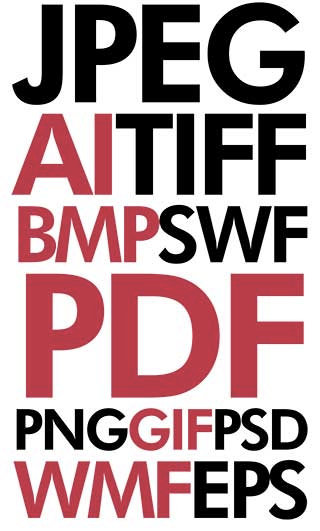What You Should Know About Graphic Design File Formats
There are so many graphic file formats available today; it’s understandable if you feel confused or overwhelmed. Which is the best one, and does it really matter in the grand scheme of things? When it comes to sending your graphics to a printer or another graphic designer, format does matter. These are the 5 most preferred formats. Next time a graphic designer or print shop asks for your format, remember to send in one of these.
Joint Photographic Experts Group (JPG or JPEG)
Joint Photographic Experts Group (JPG) is one of the most well-known file formats. It is widely used around the world for just about anything. However, it does come with limitations. A JPG doesn’t support transparent backgrounds and its level of quality varies depending on where you use it. It will be of medium quality on a website, low quality in an email, and high quality when printed on paper. This file can be used on many different platforms.
PDF (Portable Document Format)
Think of a PDF like an electronic document that you can send through emails and share online. A PDF works great when you want to see what flyers, brochures, and magazine articles will look like when they’re printed out and distributed.
Encapsulated PostScript (EPS)
Sometimes called an EPSF file, this is used for the exchange of drawings or logos and can be opened in Adobe Illustrator. It can contain almost any combination of text and images.
Graphics Interchange Format (GIF)
Some individuals use the GIF format to create an animated image, which they then post on forums or blogs. The GIF is very low in resolution and is famous for having jagged, pixelated edges. It’s not recommended for photography.
Adobe Illustrator (AI)
This format is native to Adobe Illustrator. Illustrator files are saved in a vector format, so their size can be changed without damaging the quality of the graphics.
Portable Network Graphics (PNG)
Unlike JPG files, PNG files support transparency, which is a convenient and attractive feature for graphic designers and business owners alike. This format is also lossless and ready to handle 24-bit color RGB. Some Internet browsers don’t support it.
When it comes to graphic design and print files, there are many file formats at your disposal – but these will be the ones a professional graphic designer or print company will want to work with!
LRT is a marketing and graphic solutions company specializing in offset printing, marketing, social media, graphic design, signs, banners, vehicle graphics, web design and development, SEO, blogging and content creation and anything you can imagine to help your business enhance its online presence and visibility. LRT Graphics serves a large variety of clients in Chico and surrounding North State and Northern California areas like Oroville, Paradise, Corning, Red Bluff, Redding, Orland, Reno, Sparks, Yuba City, Marysville, Sacramento and more! We would be more than happy to meet with you about your marketing, social media, web development or other marketing and graphic design project – we can do it all. Talk to the experts today!






